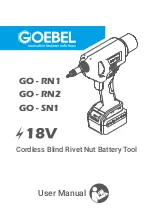
54
Veritas
®
Mk.II Power Sharpening System
Back-Bent Gouges
Back-bent gouges present no unique problems that were
not dealt with above. Today, only someone carving
endless clusters of grapes would bother buying a back-
bent gouge, since a small amount of inside bevel will let
you use a regular gouge in place of the back bent.
Veining Tools
Veiners are narrow, high-sweep gouges used for fi ne
grooving. Again, the considerations for gouges in general
apply to veining tools. The only difference is that veining
tools are so small that it is often easier to deal with
them purely manually rather than going near any power
equipment. Making your own hones from wood and
charging them with chromium-oxide honing compound
is a godsend for veining tools. It lets you touch them
up without risking geometric rearrangement, which is so
easy on tools with such a small cross section.
Parting Tools
For most carvers, these are truly the tools from hell.
They are the most diffi cult carving tool of all to grind
and hone and probably the easiest to damage in use.
One of the primary problems with parting tools is that
they are frequently badly made. They often do not have
a crisp V-shaped bottom, and the wings of the tool are
often not ground fl at on the inside. It seems to me that the
primary reason for these defects is sloppy manufacturing
processes. Japanese parting tools tend to have good
conformation even in the inexpensive sets. It is in the
European tools that you will fi nd the most problems.
You have two choices when you get a defective parting
tool. You can return it to the vendor or you can correct
it. Given the current state of world manufacturing, I
would suggest that you keep the parting tool if it only
needs a small amount of work to bring it into line. From
personal experience, I can tell you that the vendors
have a hard time fi nding perfect ones. The answer is not
just to buy Japanese ones (unless you intend carving
only softwood) because Japanese parting tools, like
Japanese chisels, are usually laminated and can be quite
temperamental in Western hardwoods.
Assuming that you have a tool with a defect like the one
shown in the top left drawing on the facing page, the best
way to restore it is with a diamond fi le. If you can fi nd
a 600x diamond fi le that is not itself defective, it does
not take long to true the wing of a parting tool, although
you will probably not get an ideally shaped V-bottom. To
clean that up, I would recommend either a 75mm (3-in.)
feather-edge fi le or a carefully fi tted micro-fi nishing
abrasive on a steel blank. Whatever you do, make sure
you have the inside of the parting tool dressed properly
before you attempt to sharpen it. If you attempted to
sharpen the defective parting tool shown in the drawing,
you would fi nd that the whole side would fall away in the
area of the defect giving you a tool that looks something
like the drawing below. The hook in the wing makes the
tool impossible to use for anything but cutting parallel to
the grain. In cross-grain cutting the fi bers will be trapped
in the hook and will tear out. The inside of a parting tool
must be straight, so that when you sharpen the wing it can
be abraded evenly and in a line parallel to the inside of
the wing.
Shaping the Heel
The whole purpose of a parting tool is to take advantage
of the play of light and shadow on the sides of the cut,
with a very clear demarcation line where they meet. For
best effect this junction must be kept sharp.
You can make the cut from a parting tool with a rounded
V look crisp if you shape the heel carefully, and you can
also make a cut from a parting tool with a sharp V look
round if you shape the heel poorly. To give yourself the
best mobility with a parting tool, you should use fairly
short bevels and then relieve the tool for some distance
back. You want a fairly short bevel so that you can
change direction quickly and still make a clean cut.
A parting tool always cuts a more obtuse angle than the
angle of its wings. Taking a 60° parting tool as an example,
it will cut a 60° V only at a 0° bevel angle. As soon as the
tool is tilted, it cuts more than a 60° V. Depending upon
the sweep of the wings, it could be cutting as much as a
90° V at a 45° lift angle. In fact, one of the early tricks
you learn with a parting tool is to increase the attack
angle when you are turning a tight curve, because it gives
you a greater relief angle and greater maneuverability. In
any event, you want to give yourself ample clearance so
that the only mark left on the wood will be the crisp V
made by the two intersecting cutting surfaces. However,
if you have a parting tool that does not have a sharp V,
Hook in wing
Short bevel
Relieved bevel
Summary of Contents for Mk.II
Page 6: ...vi Veritas Mk II Power Sharpening System ...
Page 14: ...8 Veritas Mk II Power Sharpening System ...
Page 20: ...14 Veritas Mk II Power Sharpening System ...
Page 33: ...27 Exploded Assemblies Master Parts List 5 3 13 9 7 2 14 24 21 1 6 22 20 19 18 17 16 15 23 4 ...











































